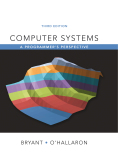
A)
Given Information:
The given code is:
// define structure
square point_color
{
// variable declaration
int c;
int m;
int y;
int k;
};
// declare structure array
struct point_color square[16][16];
int i,j;
// traverse through the array
for(i=0;i<16;i++)
{
//traverse through elements
for(j=0;j<16;j++)
{
//square all elements of the 2-D array
square[i][j].c=0;
square[i][j].m=0;
square[i][j].y=1;
square[i][j].k=0;
}
}
Write hit:
If the information in the cache is reserved or in dirty state then the cache line is updated in its place without updating memory set from its state to dirty.
- If the state of information is in valid state then it executes a write-through operation.
- It then updates the memory and block and changes its blocked state to reserved state.
Write miss:
A partial cache line write is handed as a read miss followed by a write hit. All the other caches are left in the invalid state and the reserved state is occupied by the current state.
B)
Given Information:
The given code is:
// define structure
square point_color
{
// variable declaration
int c;
int m;
int y;
int k;
};
// declare structure array
struct point_color square[16][16];
int i,j;
// traverse through the array
for(i=0;i<16;i++)
{
//traverse through elements
for(j=0;j<16;j++)
{
//square all elements of the 2-D array
square[i][j].c=0;
square[i][j].m=0;
square[i][j].y=1;
square[i][j].k=0;
}
}
Write hit:
If the information in the cache is reserved or in dirty state then the cache line is updated in its place without updating memory set from its state to dirty.
- If the state of information is in valid state then it executes a write-through operation.
- It then updates the memory and block and changes its blocked state to reserved state.
Write miss:
A partial cache line write is handed as a read miss followed by a write hit. All the other caches are left in the invalid state and the reserved state is occupied by the current state.
C)
Given Information:
The given code is:
//define structure
square point_color
{
// variable declaration
int c;
int m;
int y;
int k;
};
// declare structure array
struct point_color square[16][16];
int i,j;
// traverse through the array
for(i=0;i<16;i++)
{
//traverse through elements
for(j=0;j<16;j++)
{
//square all elements of the 2-D array
square[i][j].c=0;
square[i][j].m=0;
square[i][j].y=1;
square[i][j].k=0;
}
}
Want to see the full answer?
Check out a sample textbook solution
Chapter 6 Solutions
EBK COMPUTER SYSTEMS
- [5 marks] Give a recursive definition for the language anb2n where n = 1, 2, 3, ... over the alphabet Ó={a, b}. 2) [12 marks] Consider the following languages over the alphabet ={a ,b}, (i) The language of all words that begin and end an a (ii) The language where every a in a word is immediately followed by at least one b. (a) Express each as a Regular Expression (b) Draw an FA for each language (c) For Language (i), draw a TG using at most 3 states (d) For Language (ii), construct a CFG.arrow_forwardQuestion 1 Generate a random sample of standard lognormal data (rlnorm()) for sample size n = 100. Construct histogram estimates of density for this sample using Sturges’ Rule, Scott’s Normal Reference Rule, and the FD Rule. Question 2 Construct a frequency polygon density estimate for the sample in Question 1, using bin width determined by Sturges’ Rule.arrow_forwardGenerate a random sample of standard lognormal data (rlnorm()) for sample size n = 100. Construct histogram estimates of density for this sample using Sturges’ Rule, Scott’s Normal Reference Rule, and the FD Rule.arrow_forward
- Can I get help with this case please, thank youarrow_forwardI need help to solve the following, thank youarrow_forwardreminder it an exercice not a grading work GETTING STARTED Open the file SC_EX19_EOM2-1_FirstLastNamexlsx, available for download from the SAM website. Save the file as SC_EX19_EOM2-1_FirstLastNamexlsx by changing the “1” to a “2”. If you do not see the .xlsx file extension in the Save As dialog box, do not type it. The program will add the file extension for you automatically. With the file SC_EX19_EOM2-1_FirstLastNamexlsx still open, ensure that your first and last name is displayed in cell B6 of the Documentation sheet. If cell B6 does not display your name, delete the file and download a new copy from the SAM website. Brad Kauffman is the senior director of projects for Rivera Engineering in Miami, Florida. The company performs engineering projects for public utilities and energy companies. Brad has started to create an Excel workbook to track estimated and actual hours and billing amounts for each project. He asks you to format the workbook to make the…arrow_forward
 C++ for Engineers and ScientistsComputer ScienceISBN:9781133187844Author:Bronson, Gary J.Publisher:Course Technology Ptr
C++ for Engineers and ScientistsComputer ScienceISBN:9781133187844Author:Bronson, Gary J.Publisher:Course Technology Ptr Systems ArchitectureComputer ScienceISBN:9781305080195Author:Stephen D. BurdPublisher:Cengage Learning
Systems ArchitectureComputer ScienceISBN:9781305080195Author:Stephen D. BurdPublisher:Cengage Learning Principles of Information Systems (MindTap Course...Computer ScienceISBN:9781305971776Author:Ralph Stair, George ReynoldsPublisher:Cengage Learning
Principles of Information Systems (MindTap Course...Computer ScienceISBN:9781305971776Author:Ralph Stair, George ReynoldsPublisher:Cengage Learning Operations Research : Applications and AlgorithmsComputer ScienceISBN:9780534380588Author:Wayne L. WinstonPublisher:Brooks Cole
Operations Research : Applications and AlgorithmsComputer ScienceISBN:9780534380588Author:Wayne L. WinstonPublisher:Brooks Cole C++ Programming: From Problem Analysis to Program...Computer ScienceISBN:9781337102087Author:D. S. MalikPublisher:Cengage Learning
C++ Programming: From Problem Analysis to Program...Computer ScienceISBN:9781337102087Author:D. S. MalikPublisher:Cengage Learning Database Systems: Design, Implementation, & Manag...Computer ScienceISBN:9781305627482Author:Carlos Coronel, Steven MorrisPublisher:Cengage Learning
Database Systems: Design, Implementation, & Manag...Computer ScienceISBN:9781305627482Author:Carlos Coronel, Steven MorrisPublisher:Cengage Learning





